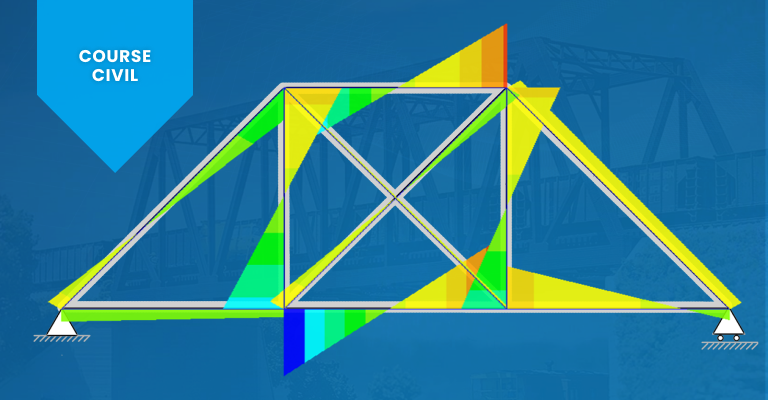-
1) What is Truss Structure
-
2) The Concept of Truss Analysis
-
3) Truss Analysis Method
-
4) Example & Tutorial
-
5) Comparison of Results

3. Truss
In this lecture, We will learn about the concepts, principles, and behaviour of the Truss structure. We will also get to know, why the Truss is effective to span large distances. And then, We will compare the results like Axial forces and deflection, of the Truss having different boundary conditions using midas Civil.
Chapter 1) What is Truss structure.
- Introduction to Truss.
- Classification of the truss.
Chapter 2) The Concept of Truss Analysis
- Behavior of truss members
- Determinate and indeterminate truss
Chapter 3) Truss analysis method
- Analysis of determinate truss
- Analysis of indeterminate truss
Chapter 4) Example
- Modelling, boundary condition setting, applying load using Midas Civil.
- Analysis and compare the results for the truss having a different configuration.
Chapter 5) Comparison of results
- Comparison of Deflection and Axial forces in members.

The member forces of trusses are derived according to the following assumptions.
① The nodes where each member meets are connected in a frictionless hinge condition.
② Each member is a straight member.
③ The central axes of each member meet at the nodes.
④ All loads are applied only at the nodes where members are connected.
Since the load acts only at the nodes, the member forces of the truss only generate tension or compression. For convenience, the tension is (+) and the compression is (-).
When judging the tension or compression of a member in truss analysis, it is convenient to think of tension when the force is directed outward based on the nodes, and compression when the force is directed in the direction of the nodes.

Truss classification from a mechanical point of view
- Statically determinate truss: A structure that can calculate the reaction force and member force only under the condition of force equilibrium
- Indeterminate truss: structure that requires additional conditions equal to the number of indeterminate orders
Classification of Indeterminate Trusses
- External Indeterminate: A structure in which the reaction force cannot be calculated only with the force equilibrium condition.
- Internal Indeterminate: Although the reaction force can be calculated under the condition of force equilibrium, the member force constituting the truss can only be calculated with additional conditions.
The formula below expresses the method for calculating the indeterminate order of a truss.

1) The solution of the determinate truss
- Nodal method : a method of analyzing a specific node as a free body diagram as a force equilibrium condition.
- Section method : a method for analyzing a free body diagram in which a truss is cut with an arbitrary cutting plane as a force equilibrium condition
2) The solution of the indeterminate truss
- Flexibility method : a method of applying fitting conditions by creating equations for the degrees of freedom selected as unknowns
